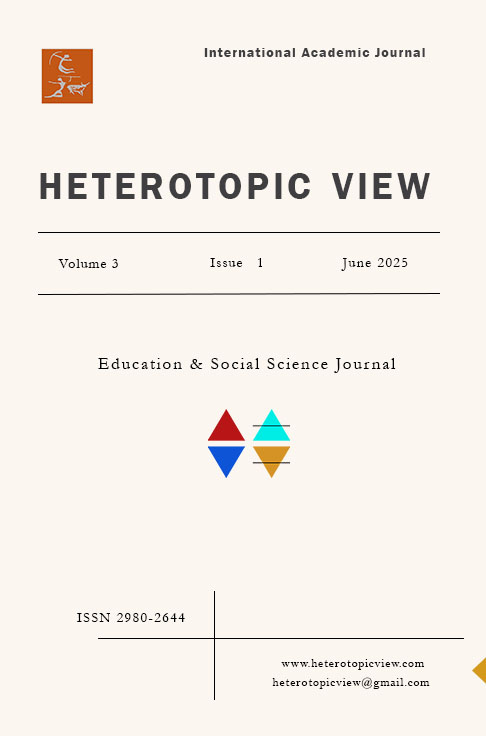Rhythmanalysis in The Construction Of Geographical Reason
DOI:
https://doi.org/10.5281/zenodo.15714787Keywords:
Geographical Reason, Rhythm, Rhythmanalysis, GeographyAbstract
This article was written to evaluate the geographical reason that David Harvey tried to reveal in his works in terms of rhythmanalysis, which Henri Lefebvre proposed as a method of analysis. Harvey emphasizes the need to bring together quantitative methodology and philosophy of geography in the discipline of geography. He stated that a geographical understanding that combines theoretical and analytical thought is necessary in order to reveal the hidden or overt aims of capital and dominant powers. He worked to establish ways and arguments through which geographical understanding and knowledge could be acquired. In this context, it is thought that associating Lefebvre's rhythms that ensure the continuity of all elements related to nature and humans with Harvey's "geographical reason" perspective will make a significant contribution to the discipline. Document analysis method was used in the study. In this context, a literature review was conducted on the concepts of “geographical reason” and “rhythmanalysis”. As a result of the study, it was understood that the formation of the geographical reason that Harvey drew the conceptual framework for and the point of how the basic concepts of geography come together can be explained with the relational and dialectical perspective of rhythmanalysis.
References
Bozkır, D. & Karabağ, S. (2023). Liberalizmin coğrafi akıl perspektifinde kozmopolitlik ve özgürlüğün sınır problemi, Heterotopic View, 1(2), 7-17. https://doi.org/10.5281/zenodo.10413214
Chen, Y. (2016). Practising rhythmanalysis: Theories and methodologies. Rowman & Littlefield.
Brown, N., & Morgan, C. (2021). Rhythmanalysis as a method to account for time in qualitative research. In B. C. Clift, J. Gore, S. Gustafsson, S. Bekker, I. C. Batlle & J. Hatchard (Eds.), Temporality in qualitative ınquiry (pp. 111-126). Routledge.
Topraklı, K. C. (2021). Sonuç odaklı eğitimin gençlere yansıması. S. Kayaarslan (Ed.), Gençlik ve eğitim çerçevesinde güncel araştırmalar içinde (s. 209-239). İksad Yayınevi.
Dinç, H., & Argan, M. (2024). Ritimanaliz bağlamında park ziyaret deneyimleri: Bir netnografi çalışması. Anatolia: Turizm Araştırmaları Dergisi, 35(2), 50-69. https://doi.org/10.17123/atad.1529278
Edensor, T. (2014). Rhythm and arrhythmia. Adey, P., Bissel, D., Hannan, K., Merriman & P., Sheller, Mimi (Eds.). The Routledge Handbook of Mobilites
Edensor, T (Eds). (2010). Geographies of rhythm nature, place, mobilities and bodies. Routledge. https://www.routledge.com/Geographies-of-Rhythm-Nature-Place-Mobilities-and Bodies/Edensor/p/book/97 81138274549 sayfasından erişilmiştir.
Elden, S. (2004). Rhythmanalysis: An introduction. H. Lefebvre (Ed.), In Rhythmanalysis: Space, time and everyday life (pp. vıı-xv). Continuum.
Elden, S. (2002). Politics, philosophy, geography: Henri Lefebvre in recent anglo-American scholarship. Antipode, 33(5), 809-825. https://www.researchgate.net/publication/229774332 sayfasından erişilmiştir.
Gümüş, İ., & Yılmaz, E. (2020). Rhythmanalysis as a method of analyzing everyday life spaces: The case of Kıbrıs Şehitleri Street in İzmir. Online Journal of Art and Design, 8(3), 229-250.
Harvey, D. (1969). Explanation in geography. Edward Arnold.
Harvey, D. (1974). What kind of geography for what kind of public policy? Transactions of the Institute of British Geographers, 63, 18–24. https://doi.org/10.2307/621527
Harvey, D. (1990). Between space and time: Reflections on the geographical imagination. Annals of the Association of American JSTOR, 80(3), 418- 434. https://www.scribd.com/document/479947929/ESPACIO-HARVEY-David-Between-Space-and-Time-Reflections-on-the-Geographical Imagination adresinden erişilmiştir.
Harvey, D. (2015). Kozmopolitlik ve özgürlük coğrafyaları (Z. C. Başeren, Çev.). İstanbul Bilgi Üniversitesi Yayınları.
Harvey, D. (2000). Reinventing geography. New Left Review, 4, 75.
Karabağ, S. (2006). Mekânın siyasallaşması. Gazi Kitapevi
Lacoste, Y. (2020). Coğrafya her şeyden önce savaş yapmaya yarar (S. Sezer, Çev.). Ayrıntı Yayınları.
Lefebvre, H. (1992). Ritimanaliz, mekân, zaman ve gündelik hayat (A. L. Batur, Çev.). Sel Yayıncılık.
Lefebvre, H. (2012). Gündelik hayatın eleştirisi-1 (I. Ergüden, Çev.). Sel Yayıncılık.
Lefebvre, H. (2015). Gündelik hayatın eleştirisi-III moderniteden modernizme (I. Ergüden, Çev.). Sel Yayıncılık.
Lefebvre, H. (2020). Mekânın üretimi (I. Ergüden, Çev.). Sel Yayıncılık.
Lefebvre, H. (2021). Diyalektik materyalizm (B. Yıldırım, Çev.). Sel Yayıncılık.
Nash, L. (2018). Performing place: A rhythmanalysis of the city of London. Sage Journals, 41(3). https://doi.org/10.1177/0170840618789161
Pattison, W. D. (1964). The four traditions of geography. Journal of Geography, 63(5), 211–216. doi.org/10.1080/00221346408985265
Sarup, M. (2004). Post-yapısalcılık ve postmodernizm (A. Güçlü, Çev.). Bilim ve Sanat Yayınları.
Shields, R. (1999). Lefebvre, love & struggle, spatial dialectics. Routledge.
Söylemez, E. & Koramaz, T. E. (2024). Rhythmanalysis theory as a dialectical method in urban geography. European Journal of Geography, 15(4), 293-304. https://doi.org/10.48088/ejg.e.soy.15.4.293.304.
Stavrides, S. (2021). Kentsel heterotopya, özgürleşme mekânı olarak eşikler kentine doğru (A. Karatay, Çev.). Sel Yayıncılık.
Downloads
Published
How to Cite
Issue
Section
License
Copyright (c) 2025 Heterotopic View

This work is licensed under a Creative Commons Attribution-NonCommercial-NoDerivatives 4.0 International License.


